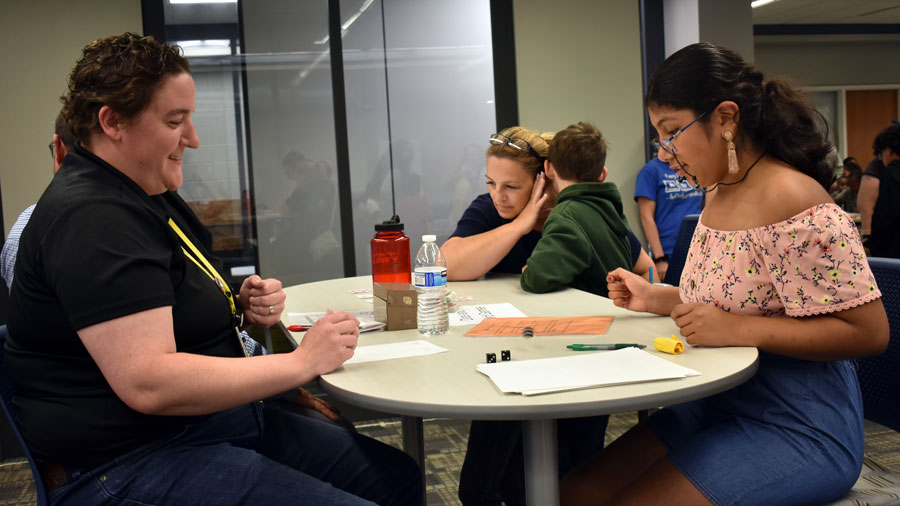Godwin Heights — High school special education math teacher Dan Draeger held up two paper chains twisted together and asked 10th-grader Jaxxen Roby a simple question.
“What shape do you think they will make?”
After a quick study, Jaxxen blurted out “A triangle.”
“OK, let’s see if you are right,” Draeger said as he began to cut the chain on its axis. He unrolled the paper to reveal two connected hearts. Jaxxen laughed.
The guess-the-shape paper chain was one of 14 STEM activities that secondary students and their parents could participate in during a recent STEM family night at Godwin High School focused on science, technology, engineering and math.
The shape activity is a lesson in geometry, Draeger explained, revealing that two chains cut on their axis will create a perfect square, while two twisted chains taped together will become two connected hearts.
“No one ever gets this one right,” he said, as he placed the hearts under a table. “Last year, we had four students guess the square. This year we have had two, and as usual no one has guessed the hearts.”
Godwin Heights High School has hosted a family STEM night for years, said instructional specialist Melissa Musial. Before 2020, the school had opened it up to all students, but last year staff decided to offer it to students in grades 6-12.
“We wanted to use it as a way to build a bridge between the middle school and the high school,” Musial said, and to give parents a chance to see and experience what students are learning. The school also hosts a family literacy night for grades 6-12 in the winter and an art show in the spring.
Games of Chance, Prediction
Set in the high school’s collaboration room, students and family members were able to go from station to station in any order. Stations featured activities with robots, coding, financial skills, chemistry and math.
“It is nice to see them getting interested in science and how things work,” said Carlos Juarez, whose daughter Jocelyn is a seventh-grader.

Two tables down from where Juarez explored coding with his youngest daughter, 10th-grader Harry Rivera sat down to once again challenge high school math teacher Patti Reeder to a game of Pig. Players try to be first to add numbers to reach 100.
“Are you sure you want to try again?” Reeder asked Harry as she passed him the dice. In a previous game, Harry only got to 22.
Harry rolled: six and nine. “That is 15,” he said, picking up the dice and rolling again. He got a 1.

“It is a little bit of a game of chance, but the key here is that the students are practicing their addition,” Reeder said.
Next to the group, eighth-graders Jada Jeffery and Payten Williams tried to predict how far they could throw a paper plate, a straw and a cotton ball.
“I learned that you need to be careful when you are predicting,” Jada said with a laugh. “I didn’t do very well.”
Rockets, Interest Soars
Meanwhile, Joycelyn had wandered outside, where she found a rocket-building activity. She carefully rolled and taped a piece of paper and closed the top.
She walked over to a rocket launcher, placed it on and then stomped a button to launch it.
“OK, it went up about a foot,” she said. “How could I get this to go higher? Could I shorten the distance between the launcher and the pump?”
Joyceln took a few minutes to look at the rocket launcher and concluded she couldn’t.
“What if I stomp slower or faster?” she said, and tried both with the rocket going about the same distance.
“I love science,” she said afterward. “I think it is interesting and maybe something I can do in the future.”
















